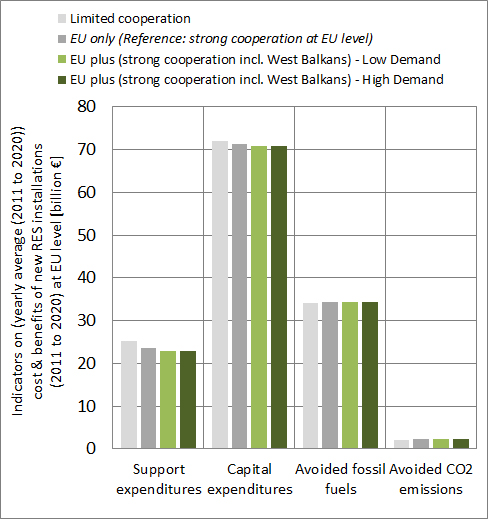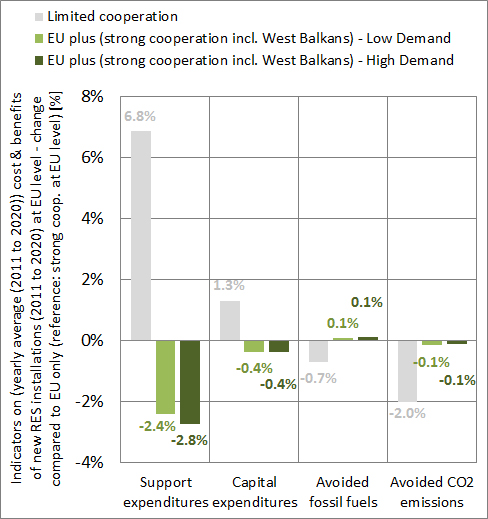

Figure 3-4 shows the costs and benefits corresponding to all assessed policy cases in absolute terms (left hand side) and as relative change compared to the reference case of strong RES cooperation, limited to the EU (EU only). The left hand side reveals that increasing cooperation - at EU level or even further to neighbouring regions like the Western Balkans - generally is beneficial as average yearly support expenditures can be lowered from EUR 25.2 billion to EUR 23.5 billion by moving from limited to strong cooperation at EU level. If, in addition, the Western Balkan regions comes into play, then saving increase even further: support expenditures for new RES installation (over the period 2011 to 2020) can be reduced by 2.4% to 2.8% on average throughout the whole assessment period. The right hand side reveals that a large fraction of the benefits is however already achieved by moving from limited to strong RES cooperation at EU level (EU only). This is further visible in the left-hand side of the graphic: the reference case compared to the limited cooperation scenario exhibits substantially stronger relative changes to the reference case as when moving from EU only (cooperation limited to EU countries) to EU plus (RES cooperation in the extended geographical context (i.e. specifically, EU plus Western Balkans within this assessment).


Figure 3-4: Indicators on yearly average (2011 to 2020) cost and benefits of new RES installations (2011 to 2020) at EU level for all assessed cases, expressed in absolute terms (billion EUR) (left) and assuming limited or strong coop-eration between Member States, expressed as deviation from the (reference) case of moderate RES cooperation (right)
As shown in Figure 3-4, a positive impact of enhanced RES cooperation with Western Balkans on costs and expenditures, in particular support expenditures for renewables, can however be expected for the European Union in the 2020 context. According to the model-based assessment, in the low demand case this can reduce the required support expenditures on average throughout the period 2011 to 2020 by 2.4% in comparison to the reference case where RES cooperation is limited to EU countries only (EU only). As a consequence of additional income through RES cooperation EU Member States may however also benefit in the high demand case. Notably, the magnitude of savings is then even higher, 2.8% can be saved on support under these circumstances.
In practical terms, the possibilities for doing so appear however more limited - it would require immediate action and a rapid removal of non-economic barriers and, in turn, a new RES policy framework to be implemented in all analysed EU and neighbouring countries at short notice.
| <<Back | >>Back to Introduction<< |